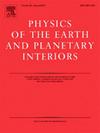类地行星的长寿命磁场
IF 1.9
3区 地球科学
Q2 GEOCHEMISTRY & GEOPHYSICS
引用次数: 0
摘要
我们不确切地知道,为行星磁场提供动力是类地行星的常见特征还是罕见特征,也不知道它可能运行了多少亿年。如果行星发电机本质上应该由内部热流驱动(即热驱动发电机,TDD),答案取决于行星内部的能量收支。在地球上,大约45亿年前形成月球的撞击提供了大量的能量,直到现在磁场仍然很强。尽管在这个问题上做了大量的工作,外核的热导率(kCond)的有争议的性质使得核心的能量预算开放讨论。本文提出了在压强为22 ~ 150 GPa、温度为1050 ~ 2700 k条件下kCond演化的新实验约束条件,通过数值模拟短热脉冲在激光加热的金刚石砧孔中加载、压缩和加热铁薄片的传播机制获得了kCond。由于覆盖了大的P-T域,我们测量的准确性使得kCond作为Fe摩尔体积和温度的函数的精确建模成为可能。在地核-地幔边界(CMB)的P-T条件下,我们得到了37(5)W/m/K的值。如果地球发电机本质上应该是TDD,这意味着CMB在整个地球历史上冷却了380-450 K,内核有19(4)亿年的历史。通过比较地幔在CMB提取热量的效率与维持TDD所需的功率,我们表明地球发电机在地核凝固之前不太可能停止。这种效应来自于随着CMB温度的降低而产生发电机的功率需求的降低。现在将我们的P-T依赖的kCond模型应用于具有不同外部半径和硅酸盐和金属分数的类地行星,我们表明核心尺寸是一个关键参数。对于小于临界尺寸的地核,地幔对流诱导了足够的CMB热流,使TDD成为可能。这可以解释火星上没有发电机的原因,如果金星的核心相对较大,金星上也可能没有发电机。计算表明,比地球重1.5倍的系外行星不太可能出现有生命的TDD,尤其是如果它们的体积密度很大的话。相比之下,迄今为止报道的小型系外行星可能拥有TDD。本文章由计算机程序翻译,如有差异,请以英文原文为准。

Long-lived magnetic field in earth-like terrestrial planets
We do not know precisely whether powering a planetary magnetic field is a common or rare feature of Earth-like planets, and for how many billion years it should likely be operating. If planetary dynamos should be driven by internal heat flow essentially (i.e. thermally driven dynamo, TDD), the answer relies on the energy budget of the planetary interior. On Earth, the Moon-forming impact provided a lot of energy ∼4.5 billion years ago and the magnetic field remains strong until present. Despite extensive work on this subject, the controversial nature of the outer-core's thermal conductivity (kCond) makes the energy budget of the core open to discussions. Here we present new experimental constraints on the evolution of kCond with pressure from 22 to 150 GPa and temperature from 1050 to 2700 K. kCond is obtained by numerical modeling of the mechanism of propagation of a short heat pulse through a thin foil of iron loaded, compressed and heated in the laser-heated diamond anvil cell. With good coverage of large P-T domains, the accuracy of our measurements enables an accurate modeling of kCond as a function of the molar volume of Fe and temperature. We refine a value of 37(5) W/m/K at P-T conditions found at the Earth core-mantle boundary (CMB). If the geodynamo should be TDD essentially, this implies CMB cooling by 380–450 K over the entire Earth history and an inner core 1.9(4) billion years old. By comparing the mantle efficiency to extract heat at the CMB with the power requirement to sustain a TDD, we show that the geodynamo is unlikely to stop until the Earth's core is solidified. This effect comes from a decreasing power requirement to generate the dynamo with decreasing the temperature at the CMB. Now applying our P-T dependent kCond model to terrestrial planets with various external radii and fractions of silicate and metal, we show that the core size is a critical parameter. For a core smaller than a critical size, mantle convection induces a sufficient CMB heat flow to enable a TDD. This can explain absence of dynamo on Mars and possibly on Venus also if its core would be relatively large. Calculations show that exoplanets 1.5 times heavier than the Earth are unlikely to present an alive TDD, especially if they present large bulk densities. In contrast, the small exoplanets reported to date could host a TDD.
求助全文
通过发布文献求助,成功后即可免费获取论文全文。
去求助
来源期刊

Physics of the Earth and Planetary Interiors
地学天文-地球化学与地球物理
CiteScore
5.00
自引率
4.30%
发文量
78
审稿时长
18.5 weeks
期刊介绍:
Launched in 1968 to fill the need for an international journal in the field of planetary physics, geodesy and geophysics, Physics of the Earth and Planetary Interiors has now grown to become important reading matter for all geophysicists. It is the only journal to be entirely devoted to the physical and chemical processes of planetary interiors.
Original research papers, review articles, short communications and book reviews are all published on a regular basis; and from time to time special issues of the journal are devoted to the publication of the proceedings of symposia and congresses which the editors feel will be of particular interest to the reader.
 求助内容:
求助内容: 应助结果提醒方式:
应助结果提醒方式:


